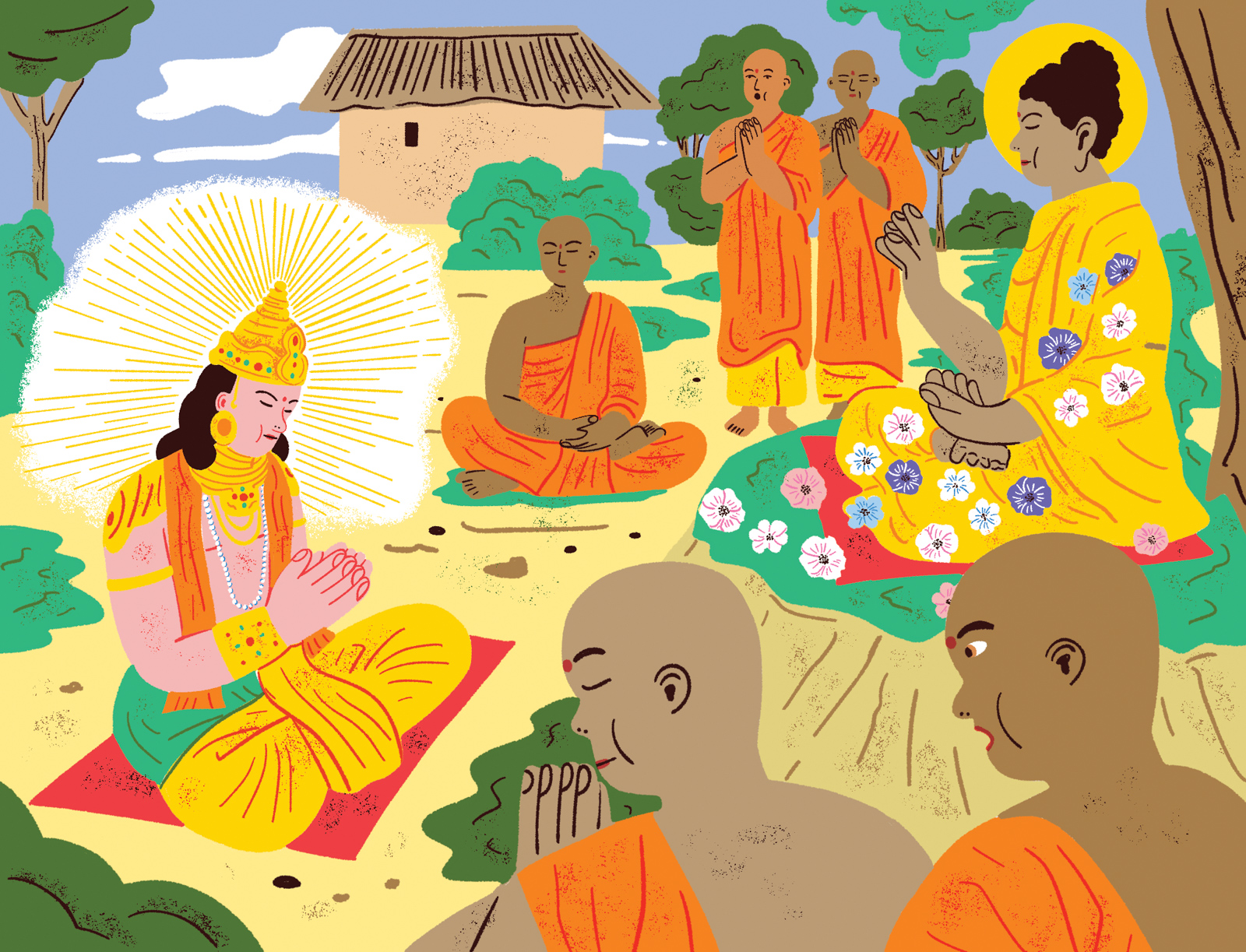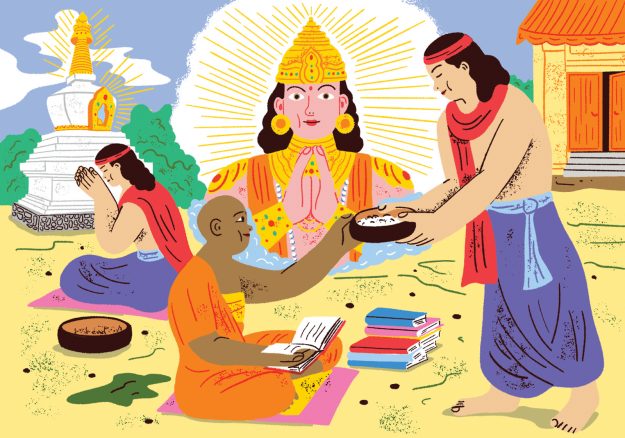
When the Blessed One was in Shravasti, there was a young god named Maniprabha who had hoops in his ears and necklaces around his neck and whose body was graced with strings of precious stones. He had a luminous celestial mansion of exquisite, divine jewels.
—Karmashataka
One of our favorite avadanas, or teaching stories, from the Karmashataka is the tale of the god Maniprabha, whose body, like the celestial mansion he lived in, shone with light and was adorned with fine jewels. One day when the Buddha was teaching at Jeta Grove (near the ancient Indian city of Shravasti), the brightly shining deity came to the garden with flowers, which he scattered over the Buddha to show homage. He then bent down to touch his head to the Buddha’s feet in a traditional gesture of respect before sitting to hear the dharma. (The image of a god bowing down to the Buddha may be surprising for some readers. But in the Buddhist framework, buddhas far exceed the gods in spiritual realization. Maniprabha’s deference to the Buddha is an embodied expression of this truth.) The Buddha offered a teaching that had such an immediate and profound effect on Maniprabha that the young god’s eventual awakening became inevitable. In celebration he rose from his seat, again touched his head to the feet of the Blessed One, circumambulated him three times, and disappeared upon the spot.
Some of the other monks in the sangha were confused. They had been studying with “continued, earnest, and sleepless efforts at dusk and dawn” when they saw Maniprabha’s great light emanate and then disappear. They went to the Buddha to ask what had happened. The Buddha explained, but the monks still had questions. They inquired how it came to be that Maniprabha had taken rebirth as a god whose residence was a celestial mansion and whose body was ornamented with divine jewels.
As is often the case in the Karmashataka, the Buddha’s response comes in the form of a story within the story. The story takes place long before Siddhartha Gautama became the Buddha—before he was even born. Back then, Buddha Kashyapa, one of the other buddhas the sutras say have appeared throughout history, was teaching the dharma. At the time, there lived in Varanasi a householder of tremendous wealth. After Buddha Kashyapa’s final passing, the householder, out of deep devotion, built a great stupa (shrine) containing the hair and nail relics of Buddha Kashyapa’s holy body. This stupa was so magnificent that even its rain gutters glimmered with jewels. Not only that, but the householder organized the construction of an associated monastery. For the rest of his life, he faithfully served the monks who studied and practiced there and provided for their every need.
The Buddha explained to the monks that after going for refuge and maintaining the fundamental precepts of a lay vow-holder all his life, the householder was reborn among the gods in a celestial mansion made of jewels. That householder’s name? Maniprabha, which means “Jewel-Light.”
Like all the stories of the Karmashataka, the story of Maniprabha is a gem that crystallizes for us certain essential teachings on karma. One facet is the enormous power of actions taken from a mindset of devotion.
When we think about our actions, we often focus on their effects, but the Buddhist view of karma easily overlooks the importance of the underlying intention. Yet as Joseph Goldstein points out, “the Buddha used the term karma specifically referring to volition, the intention or motive behind an action. He said that karma is volition because it is the motivation behind the action that determines the karmic fruit. Inherent in each intention in the mind is an energy powerful enough to bring about subsequent results.” Indeed, the Buddha stated, “Action (karma) is volition, for after having intended something, one accomplishes action through body, speech, and mind.”
The story of Maniprabha starts with a description of his numerous acts of devotion. Far from being a set of isolated occurrences, these actions are an upwelling of Maniprabha’s devotion in previous lifetimes. In honor of the earlier buddha Kashyapa, he built a magnificent stupa and an associated monastery where he rendered service all his life, and provided for the material well-being of the monastics there. But Maniprabha’s devotion was directed not only to these two buddhas. From his consistent, lifelong support of the monastery, we recognize that his devotion is also to the dharma and sangha, to notions of love and service, to compassion, and to putting others first.
In the course of the story, Maniprabha is never depicted as wavering. He appears with purpose, fulfills that purpose, and departs. Moreover, in the story of his past life, we are given to understand that the service he rendered was a joyful commitment that he never abandoned. The purity of that devotion later manifests concretely in the pristine qualities of his future rebirth in the god realm—in his brilliant appearance, his splendid ornamentation, his divine residence, and his clear intention. Practitioners will find it particularly interesting to note that his acts of devotion gave rise to the auspicious circumstances needed to receive teachings directly from a buddha. Not only that, but Maniprabha was able to comprehend the teaching so deeply that he arrived speedily at the threshold of liberation.

Seen in relation to our own practice, the potential benefits of devotion are numerous. Devotion has the quality of stabilizing the mind. When something occurs that in other contexts might set us off balance, devotion helps us stay on course. For example, at times when we hear criticism from others, we may notice that our potential reactivity and defensiveness are allayed by the depth of our conviction in the dharma. We are able to actually hear their feedback and contemplate its validity without losing our emotional center.
Devotion is akin to love: when cultivated, it grows over time. It develops within the context of an ongoing relationship. When that relationship—with a person, to the teachings generally, or to a certain lineage or practice—is healthy and not excessively predicated on projected longing, devotion matures and deepens. It is balanced. It becomes less superficial as it increases.
In keeping with our individual temperaments and inclinations, we may find ourselves drawn to certain devotional acts and disinclined to others. Traditional forms such as making offerings, building stupas, or bowing our heads or bodies are certainly important. But there are also contemporary forms more familiar to us: we can set out the cushions at the dharma center, “like and subscribe” to our favorite dharma sources on social media, or help to update Rinpoche’s iPhone. We may be spontaneously engaging in these activities without recognizing the devotion we are already expressing.
Simply attending dharma teachings with a mind that is genuinely open and receptive, not armored or argumentative, can itself be an act of devotion. It is a practice to notice where devotion already exists in our minds and hearts. That mindful awareness increases their power.
When emphasizing intention and devotion, the thought does come to us: Isn’t it enough that I’m here at the dharma talk? Or that I made it onto this cushion? Aren’t these virtuous actions good enough on their own? There can be a sense in our daily practice—and in our lives—that going through the motions is enough. This is especially true when we’re experiencing the challenges of life, and we find ourselves tired, overwhelmed, scared, anxious, busy, or burdened, as we often have every reason to be. Devotion feels like yet another item on our to-do list.
True devotion, however, does not actually drain us. It is a source of vibrant energy that makes our commitments come alive and become a source of joy.
Strengthened by devotion, we are more resilient when we encounter exhaustion, criticism, or the questions that arise naturally along the way. Our efforts will continue to grow in spite of challenges and even in response to them.
We know we’re experiencing devotion when we feel a genuine, spontaneous appreciation for the gifts we are receiving—for the fact that we can meet with qualified teachers, hear the word of the dharma, and find support in the sangha. Devotion is the wish to demonstrate this appreciation in respectful form, to pay homage as Maniprabha did.
Maniprabha leaped to repay the Buddha’s kindness without hesitation. Similarly, the dharma can inspire a realization of our wondrous good fortune that naturally overflows in an abundance of gratitude.
♦
This is the second installment in a four-part series on the Karmashataka (“A Hundred Deeds”) Sutra, a collection of ancient teaching stories on karma that has recently been translated from Tibetan into English. Read the first installation here.
The post The Karmic Power of Devotion appeared first on Tricycle: The Buddhist Review.
from Teachings – Tricycle: The Buddhist Review
https://tricycle.org/magazine/maniprabha/
from https://tricycle.org
#buddhist #buddhism
No comments:
Post a Comment